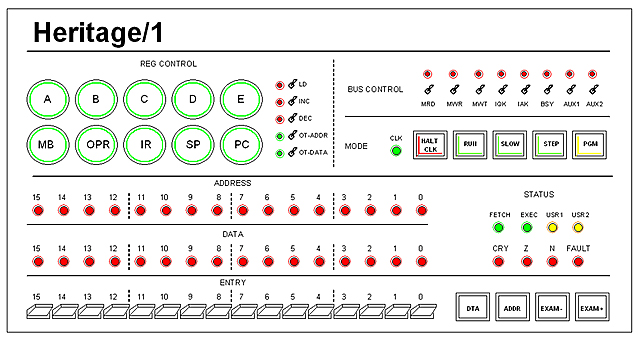Control Panel7/8/2009
Computer Control Panels have gradually simplified along history. 1950's main frames featured large panels full of lamps monitoring any single bit from the computer interior. 1970's minicomputers, in contrast, had a minimum of switches and lamps devoted mostly for entering and debugging programs in core memory.
This observation is both guiding and confusing my design of the Heritage/1 Control Panel. What exactly will I want to do from that panel apart from entering code? Debugging circuits? Watching the progress of my software in great detail down to the control signals themselves? I mean, will I want to enter individual control signals manually from the Control Panel?
I were planned to build a "BUS LAB" for that kind of "intimate debugging"; that would be a separate development tool to use during the development of the Heritage/1, that is, before the machine actually existed. But, what about to combine the two functionalities together to come with the definite Control Panel design with "intimate debugging" capabilities?
One option is to build a large panel such as that on the IBM 360 but that would be too glamorous, I think, and quite expensive too. Another option is to group functions together in the aim of saving space and resources; for example, I can place one single set (switches and LEDs) for all registers, with a register-selector key.
The other point of attention is wiring. Where exactly this control panel would be within the CPU circuitry? The natural position, I think, is in place of the Instruction Decoder and Sequencer (IDS), that is, when the computer is in "Debug Mode", the IDS is defeated and the Control Panel takes over.
This vision is very helpful when it comes to design the wiring. I am considering, for example, a "Bus Controller Card" located in the Backplane itself (not actually plugged to it). In "Normal Mode", IDS cards are connected to the buses in the Backplane; in "Debug Mode", the Bus Controller ignores signals coming from IDS cards and connects the buses to those signals coming from the Control Panel instead. As per wiring, the Control Panel would be connected directly to the Bus Controller by mean of a long ribbon cable, being the Control Panel itself located somewhere else.
As per monitoring (LEDs), I don't really need to monitor registers individually but just the Internal Data Bus. When the computer is in "Debug Mode", opening a register buffer momentarily to the internal bus will be enough for watching the register content. This will save a lot of wires and chips. Maybe some important registers such as the PC will worth their dedicated LEDs, as well as those that don't connect to the Data Bus such as the MB (Memory Bank) and other "hidden registers".
This simple but debug-capable control panel could be something similar to this:
|
Homebuilt CPUs WebRing
JavaScript by Qirien Dhaela
Join the ring?
David Brooks, the designer of the Simplex-III homebrew computer, has founded the Homebuilt CPUs Web Ring. To join, drop David a line, mentioning your page's URL. He will then add it to the list.
You will need to copy this code fragment into your page.
Project start date: May 13 of 2009
|



